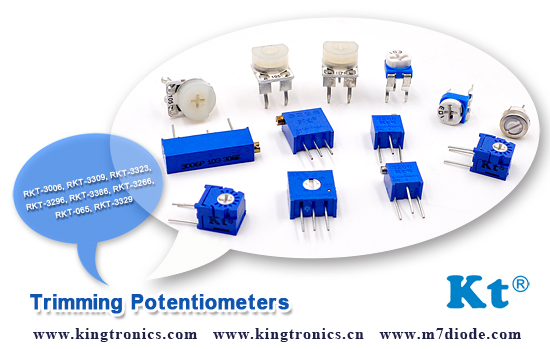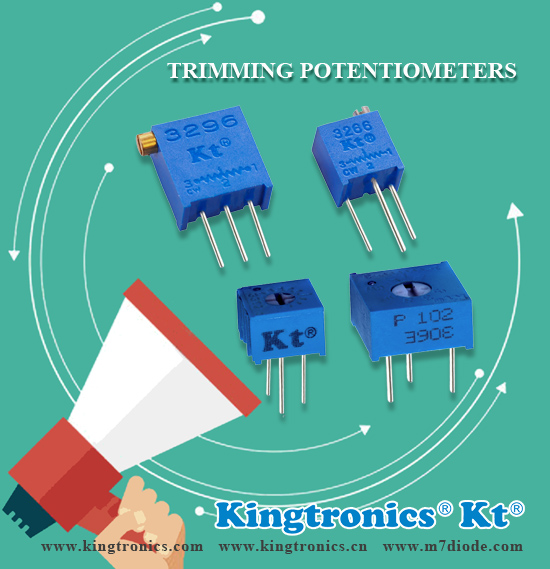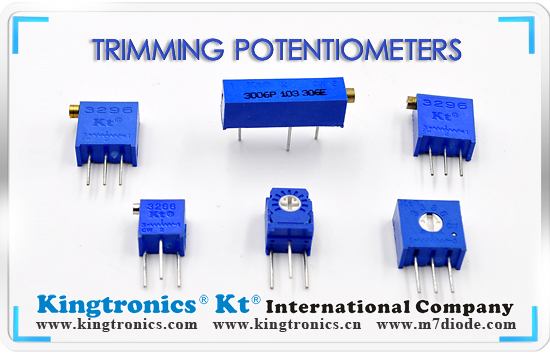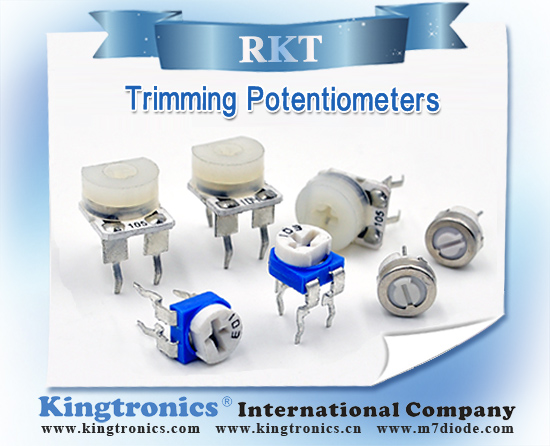Selection Criteria
The initial considerations for trimmer type selection are:
A. Resolution of adjustment
B. Setability and time to set
C. Physical and environmental conditions
D. Stability of setting required
E. Circuit packaging requirements
D. Stability of Setting
It is highly desirable that once the trimmer has been set, it should remain at that setting independent of time, operating temperature changes, vibration, shock and humidity. This property of stability is largely a factor of the compatibility of the materials at the moving contact interface and the thermal matching of the elements of the trimmer structure. BI uses noble metals in both the wire brush contact and the cermet element. These materials are relatively soft, highly compatible and provide an excellent, low resistance, non-corroding interface. The contact drive structure and materials are chosen for their stability and compatibility. The high contact forces utilized at the brush/element interface reduce susceptibility to shock and vibration.
The circuit designer can contribute significantly to short term operating and long term stability by mounting the trimmer away from high thermal gradients, hot spots and sources of excessive vibration.
E. Circuit Packaging
BI manufactures trimmers in a variety of package styles and sizes. The chances are excellent that stock models are locally available that will fit your requirements. Models include both pin style and surface mount single and multiturn configurations. Special electrical and mechanical features are available for specific customer applications. Call your local representative or the factory direct for information on special packaging.
Selection Criteria
The initial considerations for trimmer type selection are:
A. Resolution of adjustment
B. Setability and time to set
C. Physical and environmental conditions
D. Stability of setting required
E. Circuit packaging requirements
C. Physical and Environmental Issues
1. Physical considerations in trimmer selection
• Case style desired
• Top or side adjust
• Pin style required
• Mechanical support required
• Board height requirements
2. Assembly process considerations
BI offers a variety of trimmer models that are sealed to help protect against moisture and board washing processes.
•Open vs. Sealed
• Max time/temperature exposure
3. Environmental operating considerations
• Operating temperature range
• Resistance temperature coefficient
• Vibration and shock tolerance
4. Human operating conditions When you complete your design, be careful to consider the tortures that clever human beings with a screwdriver in hand can impose on trimmers. For example, while a trimmer configuration mounted on edge might be a board space saver, a trimmer that mounts flat on the board may be more resistant to abuse by a heavy handed technician making adjustments through a hole in the chassis.
Selection Criteria
The initial considerations for trimmer type selection are:
A. Resolution of adjustment
B. Setability and time to set
C. Physical and environmental conditions
D. Stability of setting required
E. Circuit packaging requirements
B. Setability and Time to Set
The enemies of setability are poor resolution, mechanical backlash and high CRV. BI has addressed these problems in the design of trimmer models. BI’s smooth cermet materials, precious metal split brush contacts and teflon rotors work together to provide outstanding setability.
“Time to set” tests show the following:
| Setting Attributes | Single Turn | Multiturn |
| High accuracy |
| Best |
| Fastest to high accuracy |
| Best |
| Fastest to approximate setting | Best | |
II. Selection Criteria
The initial considerations for trimmer type selection are:
A. Resolution of adjustment
B. Setability and time to set
C. Physical and environmental conditions
D. Stability of setting required
E. Circuit packaging requirements
A. Resolution of Adjustment
1. Multiturns
• Multiturns provide better resolution than single turns. Models with a longer element exhibit better resolution than those with a short element. Typical multiturn shaft revolutions range from 15 to 20 turns for end to end travel.
• The contact design and stability are important considerations in achieving high resolution. The contact area must be small and the contact must move smoothly in order to provide high resolution. A noisy contact will make accurate setting very difficult.
• All trimmers utilize smooth cermet materials, precious metal wire brush contacts and backlash-free wiper designs that ensure high resolution setability.
• Reference multiturn models:
Square multiturns - 44, 64, 66, 67, 68
Rectangular multiturns 78, 89
2. Single Turns
• Single turn resolution for models with a longer cermet element (larger diameter) is quite respectable. This is especially true with wire brush contacts and smooth cermet films.
• Reference single turn models:
Small diameter - 24, 25, 62, 82
Larger diameter - 72, 91, 93
3. Surface
• Single turn - 21, 23, 83
• Multiturn - 44, 84
A trimmer can be used as potentiometer or rheostat. A potentiometer is a three terminal device typically used to vary voltage. In potentiometric configurations, the wiper terminal is lightly loaded so that wiper current is generally small.
A rheostat is a two terminal device typically used to control current. Wiper current is generally larger in rheostat circuits.
I. Types of Applications
The majority of applications for trimmers occur in electronic circuits.
Typical uses are in the following devices:
A. Amplifiers
B. Timing circuits
C. Voltage and current regulators
D. Voltage and frequency converters

Kt Kingtronics Tells You Trimming Potentiometers's General Mechanical Characteristics II
10 Mar 2016WELDABILITY:
The ability of materials to be welded together under specified conditions.
TERMINAL STRENGTH:
The ability of the terminals to withstand specified mechanical stresses without sustaining damage that would affect utility of the terminals or operation of the trimming potentiometer.
IMMERSION SEALED:
The ability of the unit to withstand submersion in acceptable cleaning solutions used in normal soldering processes without performance degradation under specific environmental conditions.

TORQUE
STARTING (OPERATING) TORQUE:
The maximum moment in the clockwise and counterclockwise directions required to initiate shaft adjustment anywhere in the mechanical travel.
STOP TORQUE:
The maximum static moment that can be applied to adjustment shaft at each mechanical stop for a specified period of time without loss of continuity or mechanical damage affecting operational characteristics.
SOLDERABILITY:
The ability of the terminals to accept a uniform coating of solder under specified conditions.

Kingtronics offers full range of Trimming Potentiometers with our own trademark "Kt" since 1990.
We gain high reputation by our trimpots superior quality and competitive price. We are proud that Kingtronics Trimpot are well-known in the overseas market.
In Jan 2016, we prepared all the key raw materials of Trimming Potentiometers and then handed over to SGS laboratory.
After 1 week testing , we got the positive reply of our potentiometers from SGS company. Now we would like to share this good news with our Kingtronics faithful customer.
Kingtronics Trimming Potentiometer is your first chosie, and Kingtronics is your best partner.
More details about our RoHS 2.0 Report, please visit below link:
http://www.kingtronics.com/pdf/Trimming-potentiometer-RoHS.pdf

ROTATIONAL LIFE:
The number of cycles obtainable under specific operating conditions while remaining within specified allowable degradation. A cycle is defined as one complete traversal of the wiper over the resistive element in both directions.
LOAD LIFE:
The number of hours at which a device may dissipate rated power under specified operating conditions while remaining within specified allowable degradations.
ADJUSTABILITY:
Defines the precision with which the output of a device can be set to the desired value.
ADJUSTABILITY (OUTPUT RESISTANCE):
The precision with which the output resistance of a device can be set to the desired value.
ADJUSTABILITY (OUTPUT VOLTAGE RATIO):
The precision with which the output voltage ratio of a device can be set to the desired value.
Kt Kingtronics Tells You Trimming Potentiometers's General Electrical Characteristics IV
21 Jan 2016CONTINUITY:
Continuity is the maintenance of continuous electrical contact between the wiper and both end terminals of the resistive element.
SETTING STABILITY:
The amount of change in the output voltage, without readjustment, expressed as a percentage of the total applied voltage.
DIELECTRIC STRENGTH:
The ability to withstand the application of a specified potential of a given characteristic, between the terminals and all other external conducting member such as shaft, housing and mounting hardware without exceeding a specified leakage current value.
INSULATION RESISTANCE:
The resistance to a specified dc voltage impressed between the terminals and all other external conducting members such as shaft, housing and mounting hardware.
POWER RATING:
The maximum power that a trimming potentiometer can dissipate across the total resistive element under specified conditions while meeting specified performance requirements.
Contact us
Tel: (86) 769 8118 8110
Tel: (852) 8106 7033
Fax: (852) 8106 7099
E-mail: info@kingtronics.com
Skype: kingtronics.sales
MSN: kingtronics-sales@hotmail.com
Web: www.Kingtronics.com
YouTube: www.youtube.com/c/Kingtronicskt
About
Kingtronics International Company was established in 1995 located in Dongguan City of China to handle all sales & marketing for factories located in Chengdu, Sichuan and Zhaoqing, Guangdong, China. In 1990, we established the first factory to produce trimming potentiometer and in 1999 we built up new factory in Zhao Qing, Guangdong. Now with around 850 workers, Kingtronics produce trimming potentiometers, dipped tantalum capacitors, multilayer ceramic capacitors, and diode & bridge rectifier. We sell good quality under our brand Kingtronics, and Kt, King, Kingtronics are our three trademarks. All our products are RoHS compliant, and our bridge rectifier have UL approval. Please visit our Products page, you could please download all our PDF datasheet and find cross reference for our Trimming Potentiometer and capacitors.
Tantalum and Ceramic Capacitors Cross Reference ↓ Download
Diodes & Rectifiers List(PDF: 97KB) ↓ Download
Trimming Potentiometer Cross Reference ↓Download
Categories
- Kt Kingtronics (245)
- Diodes & Rectifiers (160)
- Aluminum Electrolytic Capacitor (149)
- Trimming Potentiometers (123)
- Tantalum Capacitors (94)
- Multilayer Ceramic Capacitors (70)
- Kt Bridge Rectifier (64)
- Quartz Crystals (58)
- Surge Arresters (34)
- Tactile Switches (32)
- Kt Kingtronics Components (30)
- Ceramic Trimmer Capacitors (25)
- Film Capacitors (23)
- Super Capacitors (17)
- Metal Oxide Varistor (10)
- Negative Temperature Coefficient Thermistor (6)
- Music capacitors (2)
Archives
- 2024 April (3)
- 2024 March (2)
- 2024 February (2)
- 2024 January (3)
- 2023 December (1)
- 2023 November (2)
- 2023 October (1)
- 2023 September (2)
- 2023 August (2)
- 2023 July (4)
- 2023 June (12)
- 2023 May (6)
- 2023 April (4)
- 2023 March (3)
- 2023 February (2)
- 2023 January (1)
- 2022 December (3)
- 2022 November (2)
- 2022 October (3)
- 2022 September (4)
- 2022 August (3)
- 2022 July (3)
- 2022 June (2)
- 2022 May (3)
- 2022 April (4)
- 2022 March (4)
- 2022 February (2)
- 2022 January (3)
- 2021 December (4)
- 2021 November (3)
- 2021 October (4)
- 2021 September (4)
- 2021 August (4)
- 2021 July (4)
- 2021 June (5)
- 2021 May (4)
- 2021 April (3)
- 2021 March (4)
- 2021 February (4)
- 2021 January (4)
- 2020 December (5)
- 2020 November (4)
- 2020 October (4)
- 2020 September (7)
- 2020 August (8)
- 2020 July (9)
- 2020 June (8)
- 2020 May (9)
- 2020 April (11)
- 2020 March (6)
- 2020 February (4)
- 2020 January (4)
- 2019 December (6)
- 2019 November (7)
- 2019 October (6)
- 2019 September (5)
- 2019 August (9)
- 2019 July (6)
- 2019 June (4)
- 2019 May (16)
- 2019 April (6)
- 2019 March (6)
- 2019 February (9)
- 2019 January (5)
- 2018 December (4)
- 2018 November (4)
- 2018 October (5)
- 2018 September (8)
- 2018 August (10)
- 2018 July (7)
- 2018 June (12)
- 2018 May (22)
- 2018 April (4)
- 2018 March (4)
- 2018 February (8)
- 2018 January (13)
- 2017 December (4)
- 2017 November (4)
- 2017 October (5)
- 2017 September (4)
- 2017 August (21)
- 2017 July (7)
- 2017 June (5)
- 2017 May (4)
- 2017 April (4)
- 2017 March (9)
- 2017 February (8)
- 2017 January (8)
- 2016 December (10)
- 2016 November (16)
- 2016 October (8)
- 2016 September (10)
- 2016 August (13)
- 2016 July (12)
- 2016 June (10)
- 2016 May (14)
- 2016 April (8)
- 2016 March (10)
- 2016 February (6)
- 2016 January (8)
- 2015 December (10)
- 2015 November (8)
- 2015 October (3)
- 2015 July (5)
- 2015 June (9)
- 2015 May (7)
- 2015 April (8)
- 2015 March (9)
- 2015 February (7)
- 2015 January (5)
- 2014 December (13)
- 2014 November (4)
- 2014 October (4)
- 2014 September (5)
- 2014 August (4)
- 2014 July (4)
- 2014 June (4)
- 2014 May (4)
- 2014 April (4)
- 2014 March (5)
- 2014 February (3)
- 2014 January (4)
- 2013 December (8)
- 2013 November (9)
- 2013 October (10)
- 2013 September (9)
- 2013 August (11)
- 2013 July (10)
- 2013 June (3)
- 2013 May (4)
- 2013 April (5)
- 2013 March (2)
- 2013 February (1)
- 2013 January (3)
- 2012 December (5)
- 2012 November (6)
- 2012 October (5)
- 2012 September (10)
- 2012 August (11)
- 2012 July (11)
- 2012 June (12)
- 2012 May (14)
- 2012 April (10)
- 2012 March (14)
- 2012 February (10)
- 2012 January (6)
- 2011 December (9)
- 2011 November (11)
- 2011 October (10)
- 2011 September (13)
- 2011 August (14)
- 2011 July (13)
- 2011 June (13)
- 2011 May (13)
- 2011 April (14)
- 2011 March (27)
- 2011 February (13)
- 2011 January (24)
- 2010 December (21)
- 2010 November (12)
- 2010 October (11)


